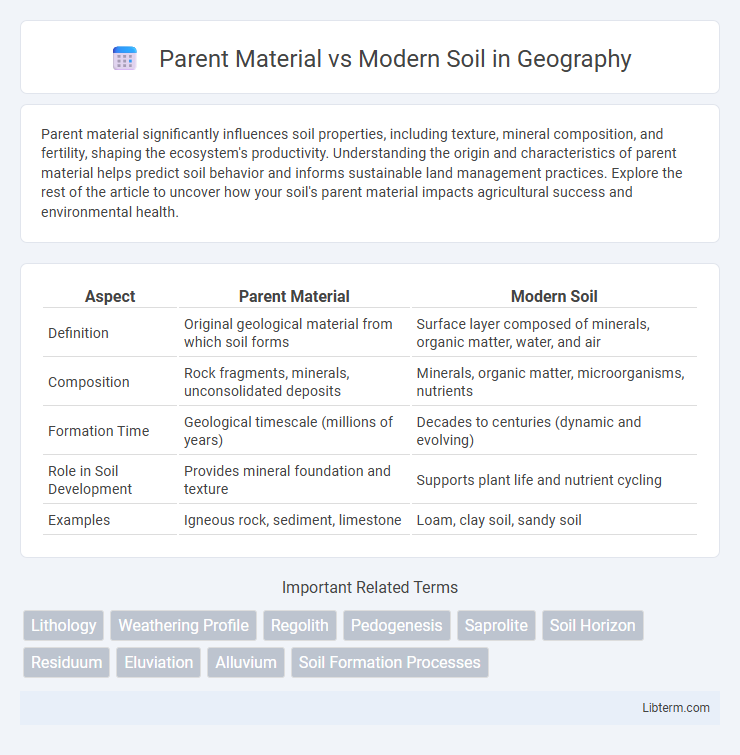Parent material significantly influences soil properties, including texture, mineral composition, and fertility, shaping the ecosystem's productivity. Understanding the origin and characteristics of parent material helps predict soil behavior and informs sustainable land management practices. Explore the rest of the article to uncover how your soil's parent material impacts agricultural success and environmental health.
Table of Comparison
| Aspect | Parent Material | Modern Soil |
|---|---|---|
| Definition | Original geological material from which soil forms | Surface layer composed of minerals, organic matter, water, and air |
| Composition | Rock fragments, minerals, unconsolidated deposits | Minerals, organic matter, microorganisms, nutrients |
| Formation Time | Geological timescale (millions of years) | Decades to centuries (dynamic and evolving) |
| Role in Soil Development | Provides mineral foundation and texture | Supports plant life and nutrient cycling |
| Examples | Igneous rock, sediment, limestone | Loam, clay soil, sandy soil |
Introduction to Parent Material and Modern Soil
Parent material refers to the underlying geological material, such as bedrock or sediment, from which soil develops through weathering processes that influence soil texture, mineral content, and fertility. Modern soil, shaped by natural and human-induced factors, exhibits complex horizons and enhanced nutrient cycling, reflecting ongoing biological activity and environmental interactions. The transformation from parent material to modern soil involves physical, chemical, and biological processes that determine soil properties essential for agriculture and ecosystem sustainability.
Defining Parent Material: The Foundation of Soil
Parent material, the underlying geological material from which soil develops, fundamentally shapes soil properties such as texture, mineral composition, and fertility. It includes bedrock, glacial deposits, or alluvial sediments, serving as the primary source of mineral nutrients. Understanding parent material is essential for predicting soil behavior, supporting agriculture, and managing land sustainably.
What Constitutes Modern Soil?
Modern soil consists of a complex mixture of mineral particles derived from parent material, organic matter, air, and water, which together support plant growth and microbial activity. It incorporates weathered rock fragments from parent material alongside decomposed organic substances, resulting in nutrient-rich layers essential for ecosystems and agriculture. Soil structure, pH balance, and microbial populations differentiate modern soil from raw parent material, enabling vital biochemical cycles and soil fertility.
Formation Processes: Parent Material vs. Modern Soil
Parent material consists of the underlying geological substance from which soil develops, formed through weathering of rocks and mineral deposits. Modern soil results from the complex interaction of parent material with organic matter, climate, microorganisms, and environmental factors over time. Soil formation processes include physical disintegration, chemical alteration, and biological activity, transforming parent material into fertile soil layers.
Key Differences between Parent Material and Modern Soil
Parent material consists of the original mineral and organic substances from which soil forms, while modern soil is a complex, developed layer containing organic matter, minerals, microorganisms, and nutrients. Parent material primarily influences soil texture and mineral content, whereas modern soil exhibits distinct horizons shaped by weathering, biological activity, and environmental processes. The key difference lies in modern soil's enhanced fertility and structure due to ongoing biological and chemical transformations absent in the parent material.
The Role of Parent Material in Soil Fertility
Parent material significantly influences soil fertility by providing the essential minerals and nutrients that form the foundation for soil development and plant growth. Soils derived from volcanic ash or limestone parent materials tend to have higher fertility due to their rich mineral content and better nutrient retention. In contrast, modern soils altered by erosion or human activity may exhibit depleted fertility, highlighting the critical role of original parent material in maintaining soil health and productivity.
Human Influence on Modern Soil Development
Human activities significantly accelerate the transformation of parent material into modern soil through processes such as agriculture, urbanization, and industrialization, which alter soil composition and structure. These influences introduce pollutants, change organic matter content, and disrupt natural soil formation, leading to soil compaction, erosion, and nutrient depletion. Modern soil development reflects anthropogenic impacts that differentiate it from natural soils formed solely under geological and climatic conditions.
Impact on Soil Properties: Texture, Structure, and Chemistry
Parent material directly influences soil texture by determining the mineral composition and particle size distribution, affecting soil drainage and aeration. Soil structure evolves from the breakdown of parent material combined with organic matter accumulation, impacting root penetration and water retention. Chemical properties such as pH, nutrient availability, and cation exchange capacity are shaped by the mineralogy of the parent material, while modern soil management practices can alter these traits through amendments and cultivation.
Environmental Factors Affecting Both Parent Material and Modern Soil
Parent material, originating from bedrock or transported sediments, is primarily influenced by geological factors such as mineral composition, weathering processes, and erosion patterns, which set the foundation for soil formation. Modern soil development is affected by a combination of environmental factors including climate (temperature and precipitation), biological activity (microorganisms, plant roots), topography, and human interventions like agriculture and pollution. Both parent material and modern soil exhibit interactions where environmental conditions dictate mineral alteration rates, organic matter accumulation, and soil texture, ultimately defining soil fertility and ecosystem sustainability.
Conclusion: Integrating Parent Material with Modern Soil Management
Integrating parent material knowledge with modern soil management techniques enhances nutrient retention and soil structure, promoting sustainable agricultural productivity. Understanding the mineral composition and weathering processes of parent materials guides precise soil amendments and erosion control strategies. This synergy optimizes soil health, ensuring resilience against environmental stressors and long-term crop yield stability.
Parent Material Infographic

 libterm.com
libterm.com